This post is now available on my gardening blog.
I think this has been my year of getting obsessed with gardens.
With the flexibility of hours that a freelancer can (sometimes) call upon, I was able to take a much greater interest in the garden, and vary it with the seasons. Alongside that, I started doing two things I'd never done before, in earnest: keeping up with gardening programmes (GQT, GW, Beechgrove, and many of the other short series); and following gardeners on Twitter. Whenever I came back from holiday, I had an archive binge: especially with the Chelsea flower show, which all happened while I was in Spain.
I'm not yet in the rhythm of doing regular blogposts about my gardening (especially not here on my more technical blog) so here's something of a review of the year, to hopefully put my thoughts on the season—if not the season itself—to sleep.
Fruit and vegetables
We arguably started planting food crops too early this year, as we lost most of our first crop of carrots. It didn't help that two big bags of New Horizon organic vegetable compost—usually so reliable—made a pretty poor top dressing: under-rotted, and more like woodchip than actual compost.
Once the weather started to warm up, growth really took off, although lots of what we did grow got eaten. Lettuce did well, though (Tom Thumb and Salad Bowl), getting started before the pests came out, and we got some good, hearted lettuces out of that sowing. A much later planting of the same crops (July, sown outdoors) came up as seedlings, but then disappeared completely overnight. This will be a theme of this blogpost: wait and see.
To avoid repeating last year's mistake of planting tomatoes in our square-metre raised bed, and letting them take it over, I constructed a separate tomato-cane support, made from the same batch of reused pallet wood:
The Moneymakers we grew on these supports did all right in their growbag, although maintenance (feeding and watering) was an issue, and I can't say the plants grew strongly. Far better was the tomato we raised in a biggish, deepish pot, and whose final green crop (the decorators dropped something heavy on the plant, forcing our hand) is busy ripening in a drawer:
Sadly, that particular tomato plant was a gift from the Oxfordshire CAG network, so I don't know what variety it was.
Here's a photo of our last ever harvest of the year:
As you can see, celery was a surprising success: shop-bought seedlings faring better than home-grown ones. It still took a whole season to grow decent-sized hearts, though. Squashes were a surprising failure: huge setbacks thanks to pests eating away at the main shoots, and in total around 3 miniature Butterbush squashes from 8 plants (the first set of four didn't even germinate.)
We've cleared the bed now, and planted Musselburgh leeks, and Aguadulce and Sutton broad beans, for overwintering: our first attempt to do so and also my first intentional selection of heritage varieties. We did get a lot of food from the bed this season, but between last year's brassica failure (eaten by cabbage whites) and this year's soft-growth failure (eaten by other nasties) we're having to think long and hard about what to grow next year.
Mixed border & other plantings
This year I put together my first attempt at an actual garden design, and I blogged about it too: building a mixed border, so I won't dwell on it too much more here. Even now some of it has died back, though, it's still looking pretty good:
I'm trying to train the pyrocantha like Oxford Botanic Garden do, hence the interesting "fruit" hanging from it. As you might also be able to see, those poor dahlias—stripped bare of all leaves—were eventually replaced by zonal pelargoniums, which went crazy, and two fuchsias, which were completely hidden by the pelargoniums. I might try to rescue them if I've got time before the frosts set in.
Elsewhere and indoors, I've been trying to propagate an entirely different pelargonium: P. peltatum "Mini Cascade Pink". This outshone all of the old zonal ones, with its more delicate pink flowers and almost succulent leaves. I haven't had much success, with most of my cuttings going yellow and wilting, but I've now made a new set so we'll see.
Lawn improvements
Our lawn was a disaster when we moved in—burned by dog urine—and it's been the work of three or four years now to rescue it to the point where it's at least a continuous mat of clover with some grass sticking through. But this year I wanted to improve it all over again, and the first step was to start feeding it more, and edge it with a half-moon tool:
I also took the opportunity to bury a large amount of creeping buttercup that was taking over in the corner just off to the right on that photo. Straight away it improved, and I think the channel formed by the edging has even helped the drainage a bit, taking water away from the main body of the lawn during the wettest weather.
The other project with the lawn—still a work in progress, and very much yielding mixed results—was to topdress and re-seed it. This was intended to both improve the quality of the turf and also try to suppress some of the weeds. Following the advice of such as Hessayon, I added a good deal of topsoil and sand (around 4-10cm depending on the divots in the surface) and maybe that was too much. The grass has grown back very patchily, and I'm not convinced the seed, purchased earlier in the year, was still good.
A good few weeks, and a bit more seeding later, it's starting to look OK again from the patio:
However, I won't show you an aerial view from our upstairs window, for shame's sake. Still, the bare patches aren't bare the way that the lawn used to go bare: they're not muddy, and compacted, and ugh. They're good soil. Fingers crossed for next year's growth.
Gardens I visited
Finally, away from my own garden, I got inspiration from a number of other places:
- Chateau Villandry An absolute must-see garden, or really gardens, near the confluence of the Cher into the Loire. A huge assortment of formal, box-hedged parterres, a herb garden, a water garden, a maze, the new "sun garden" and other wilder creations.... I understand gardeners who look at parts of it and say "well, I wouldn't want my garden to look like that": neither would I, but Villandry is the great aesthetic laboratory of a whole genre of other gardens, many of which would quite suit the average gardener.
- Portmeirion and y Gwyllt Portmeirion's famous for other reasons, of course: but it was the gorgeous planting throughout the site that really caught my eye, starting with clouds of fluffy hydrangeas along every driveway and continuing through the formal gardens out into y Gwyllt, the wilder forests that include roaming rhododendrons, lounging gunneras, red birch, magnolias and a lot more.
- Oxford Botanic Gardens Despite living in Oxfordshire permanently for 15 years now (and the first six of those in Oxford), I had never gone to the botanic gardens. Even as a student for four years before those fifteen, I found the cost incompatible with my penury! But I'm so glad I've done so now. The historic tree planting, including specimens from during the civil war, the rows of familial plants that brought about so many aha moments ("so that's in asteraceae as well!") the water gardens, and the greenhouses full of lilies, palms, succulents, musaceae, tobacco plants, piper nigra: even the pyrocantha down the front walls! I've been three times now, and each was different: I'm looking forward to a late autumn visit, just to see what it's like.
- Cogges and Heeley Farm Cogges is on our doorstep, of course: but it was an extra inspiration for me this year, as I was able to branch out into a few other tasks, and do a fair bit of planting, lifting, dividing.... So it was nice to compare it with Heeley Farm, when our friends in Sheffield took us there a few months ago. Heeley Farm is by its nature a more active, evolving site—it has little heritage to maintain, and so can try new things without worrying about digging up Anglo-Saxon foundations!—and hence has a much greater emphasis on trying new things in order to be an imperfect inner-city farm of 2014, rather than preserving the farming of yesteryear in a museum. Two urban farms; two entirely different ethoses: visiting both in reasonably quick succession was an eye-opener.
This year and next year
Despite what I used to think, seasons never really end; there isn't really a "this year" and "next year". As I say, we're overwintering veg for the first time; I'm working to keep my pelargonium cuttings alive; and there's painting of shed, fence panels and bench to keep me busy should nothing green and growing need my attention.
But I know I need to think ahead to next year, because some of the most enjoyable and most productive gardening is done over a mug of tea in December. I think the mixed border needs all-year-round interest, and I have to work out how to do that: looking at what's flowering right now should hopefully help me to remember rudbeckias and cosmos, when I'm scratching my head in April. Away from the borders, I'd like to do something with bulbs that doesn't involve working around straggly half-dead daffodils for months afterwards: something with pots, I'd wager. The lawn will also need a lot of work, but it's a far better foundation for that effort now. And I need to look at maximising productivity from the raised bed, alongside growing new varieties (and hopefully more heritage types). And who knows? maybe next year we'll finally have our allotment (after over five years on the waiting list: thanks, Witney Town Council!)
But in the mean time, I need to also sit back with that same mug of tea and think about the garden I've achieved this year: for all its faults, something new and exciting, that I've enjoyed in some or other kind of bloom for over eight months.
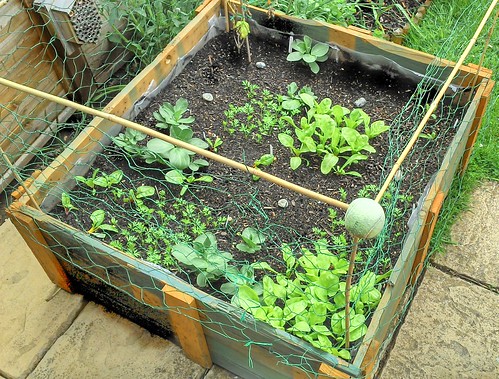

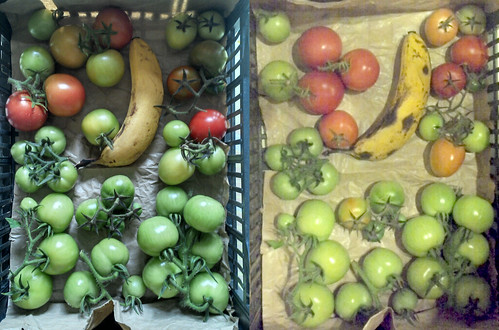
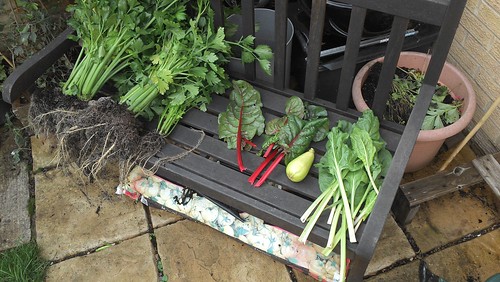
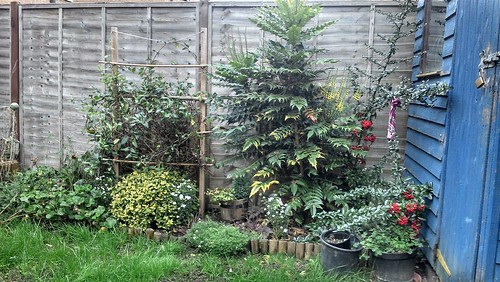
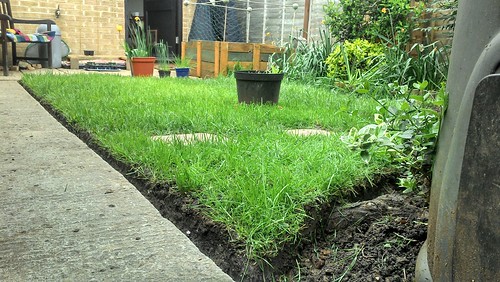

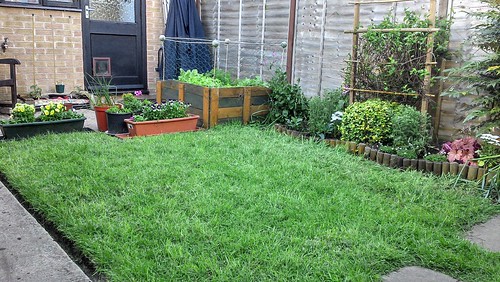

Comments
Julieanne Porter (not verified)
Thu, 23/10/2014 - 15:47
Permalink
It's good to do an overview
It's good to do an overview and it's clear from the above that you have achieved a lot this year. As you are seeing, every year is different and what does well one year fails the next. I also had no luck with pumpkins this year, with any that did develop them promptly rot off. Conversely, i had my best year ever with French beans.
In respect of your lawn, how much do you really use it? Is it worth all the fuss ans effort? Maybe it could be converted into more beds for ornamentals and food? Just a thought.
I'm personally delighted and excited to have a friend getting addicted to all things gardening. Maybe we could go to Chelsea together next year?!
jp.stacey
Thu, 23/10/2014 - 16:22
Permalink
The lawn is currently more of
The lawn is currently more of a project for the sake of it, than anything else: it's been good to learn tricks like the edging. If we'd have really wanted a pristine lawn we'd have just re-turfed it.
We did use it a lot back in 2013, but less so since we moved the bench somewhere with more shade and space to lounge in this year. Also since, yeah, I started dicking around with it this year, narrowing the window of time during which it was possible to lie on the grass (clover, really!)
I think a trip to Chelsea next year would be an excellent plan: the only thing is to avoid my Mum's birthday on May 5, but then the website is claiming it's "19 – 23 May 2015", so that might work out fine....
jp.stacey
Sun, 16/11/2014 - 15:58
Permalink
For reference, almost all of
For reference, almost all of those tomatoes ripened, in the dark, presumably thanks to the banana. The only exceptions were three or four, that were all the size of marrowfat peas and so probably just didn't have enough starch in them to start the process.
All I would say is: change the banana reasonably often. Whenever one started to rot, the tomato vines tended to get a little fur on them too.